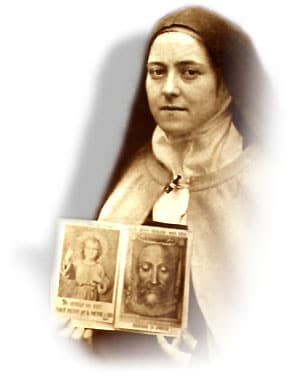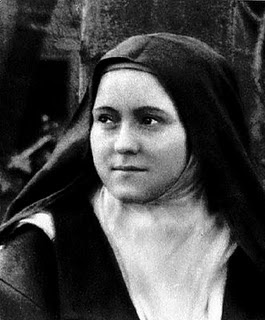Biography St Therese of Lisieux
St Therese of Lisieux
St
Therese of Lisieux (1873-1897) was a French Catholic who became a
Carmelite nun at an early age. She died in obscurity at the age of 26,
however, after her death her autobiography – Story of a Soul
was published and became a best-seller around the world. Her books
explained her spiritual path of love and selflessness, and she became
one of only three females to be considered a doctor of the Catholic
Church.
Short bio of St Therese of Lisieux
 From
an early age it was Therese’s ambition and desire to be a saint. She
was born into a pious and loving Catholic family. She remembers the
idyll of her early childhood, spending time with her parents and five
sisters in the un-spoilt French countryside. However this early
childhood idyll was broken by the early death of her Mother (from breast
cancer). Aged only 4 years old, she felt the pain of separation and
instinctively turned to the Virgin Mary for comfort and reassurance. The
next couple of years of St Therese’s’ life was a period of inner
turmoil. She was unhappy at school, where her natural precociousness and
piety made other school children jealous. Eventually her father agreed
for Therese to return home and be taught by her elder sister, Celine.
From
an early age it was Therese’s ambition and desire to be a saint. She
was born into a pious and loving Catholic family. She remembers the
idyll of her early childhood, spending time with her parents and five
sisters in the un-spoilt French countryside. However this early
childhood idyll was broken by the early death of her Mother (from breast
cancer). Aged only 4 years old, she felt the pain of separation and
instinctively turned to the Virgin Mary for comfort and reassurance. The
next couple of years of St Therese’s’ life was a period of inner
turmoil. She was unhappy at school, where her natural precociousness and
piety made other school children jealous. Eventually her father agreed
for Therese to return home and be taught by her elder sister, Celine. She
enjoyed being taught at home, however after a while, her eldest sister
made a decision to leave home and enter the local Carmel Convent at
Lisieux. This made Therese feel like she had lost her second mother.
Shortly afterwards Therese experienced a painful illness, in which she
suffered delusions. The doctors were at a loss as to the cause. For
three weeks she suffered with a high fever. Eventually Therese felt
completely healed after her sister’s placed a statue of the Virgin Mary
at the foot of the bed. Therese felt her health and mental state
returned to normal very quickly. Soon after on Christmas Eve 1884, she
recounts having a remarkable conversion of spirit. She says she lost her
inclination to please herself with her own desires. Instead she felt a
burning desire to pray for the souls of others and forget herself. She
says that on this day, she lost her childhood immaturity and felt a very
strong calling to enter the convent at the unprecedented early age of
fifteen.
She
enjoyed being taught at home, however after a while, her eldest sister
made a decision to leave home and enter the local Carmel Convent at
Lisieux. This made Therese feel like she had lost her second mother.
Shortly afterwards Therese experienced a painful illness, in which she
suffered delusions. The doctors were at a loss as to the cause. For
three weeks she suffered with a high fever. Eventually Therese felt
completely healed after her sister’s placed a statue of the Virgin Mary
at the foot of the bed. Therese felt her health and mental state
returned to normal very quickly. Soon after on Christmas Eve 1884, she
recounts having a remarkable conversion of spirit. She says she lost her
inclination to please herself with her own desires. Instead she felt a
burning desire to pray for the souls of others and forget herself. She
says that on this day, she lost her childhood immaturity and felt a very
strong calling to enter the convent at the unprecedented early age of
fifteen.
St Therese was drawn to pray for sinners. Although her
father tried to keep newspapers out of the house, she became aware of
the notorious – unrepentant killer Henri Pranzini, who was due to be
executed in 1887. Therese prayed for his last minute conversion and was
able to read in the newspaper of his last-minute grab for a crucifix as
he approached the scaffold. He kissed the wounds of Jesus three times
before being guillotined.
St Therese audience with the Pope
Initially
the Church authorities refused to allow a girl, who was so young to
enter holy orders. They advised her to come back when she was 21 and
“grown up”. However Therese’s mind was made up, she couldn’t bear to
wait; she felt God was calling her to enter the cloistered life. Therese
was so determined she travelled to the Vatican to personally petition
the Pope. Breaking protocol she spoke to the Pope asking for permission
to enter a convent. Slightly taken aback Pope Leo XIII replied “Well, my
child, do what the superiors decide.” Soon after, her heart’s desire
was fulfilled, and she was able to join her two sisters in the Carmelite
convent of Lisieux.
“Our fulcrum is God: our lever, prayer; prayer which burns with love. With that we can lift the world!”
– St Therese
Convent
life was not without its hardships; it was cold and accommodation was
basic. Not all sisters warmed to this 15-year-old girl. At times she
became the subject of gossip, and one of her superiors took a very hash
attitude to this young “spoilt middle class” girl. However Therese
sought always to respond to criticism and gossip with the attitude of
love. No matter what others said Therese responded by denying her sense
of ego. Eventually the nun who had criticised Therese so much said. “why do you always smile at me, Why are you always so kind, even when I treat you badly?”
Love attracts love, mine rushes forth unto Thee, it would fain fill up the abyss which attracts it; but alas! it is not even as one drop of dew lost in the Ocean. To love Thee as Thou lovest me I must borrow Thy very Love – then only, can I find rest.
– St Therese
This
was the “little way” which Therese sought to follow. Her philosophy was
that – what was important was not doing great works, but doing little
things with the power of love. She believed that if we can maintain the
right attitude, then nothing shall remain that can’t be accomplished.
Therese
had ambition to become a missionary and travel to Africa or China.
However, ill health curtailed these plans and she was forced to stay in
the convent.
Towards the end of her life, when she was
increasingly bed-ridden, St Therese was encouraged by the elder nuns to
write down her way of spiritual practise. She wrote three books that
explained her “little way” and included her personal spiritual
autobiography ‘Story of a Soul’.
“The good God does not need years to accomplish His work of love in a soul; one ray from His Heart can, in an instant, make His flower bloom for eternity…”
– St Therese
St
Therese died tragically early at the age of 24 from tuberculosis.
However after her death, the writings became avidly read by, first other
nuns, and then the wider Catholic community. Although initially
intended only for a small audience, her books have been frequently
republished. In 1997, St Therese was declared one of the only three
female Doctors of the Catholic Church (there are 33 doctors of the
church in total). Thus after her death she was able to achieve her
intuitive feeling that she would be able to do something great and help
save souls.
St Therese was canonized by Pope Pius XI on May 17, 1925, only 26 years after her death.
Pope Francis
(elected 2013) has said St Therese is his favourite saint and keeps a
picture of her on his bookcase. Explaining his choice for St Therese,
Pope Francis remarked...
Subscribe to:
Post Comments (Atom)


Sonic ice cream and shakes are the perfect combination for anyone looking to indulge in a refreshing dessert or a sweet snack, whether it’s a hot summer day or just a craving for something delicious, and the menu’s variety allows you to pair a rich, creamy shake with your favorite ice cream flavor, or try seasonal specials that often feature unique flavor combinations, creating a fun and satisfying treat that keeps customers coming back again and again, while the nostalgic drive-in atmosphere adds an extra layer of enjoyment to the overall experience.
ReplyDeleteThat's a really helpful explanation, thank you. It sounds like managing moisture is the most critical part of the process. To make sure I'm understanding correctly, when you mention the weep holes, is that where the cavity wall tray directs the water out? I want to be sure I visualize the entire system properly before we proceed.
ReplyDelete